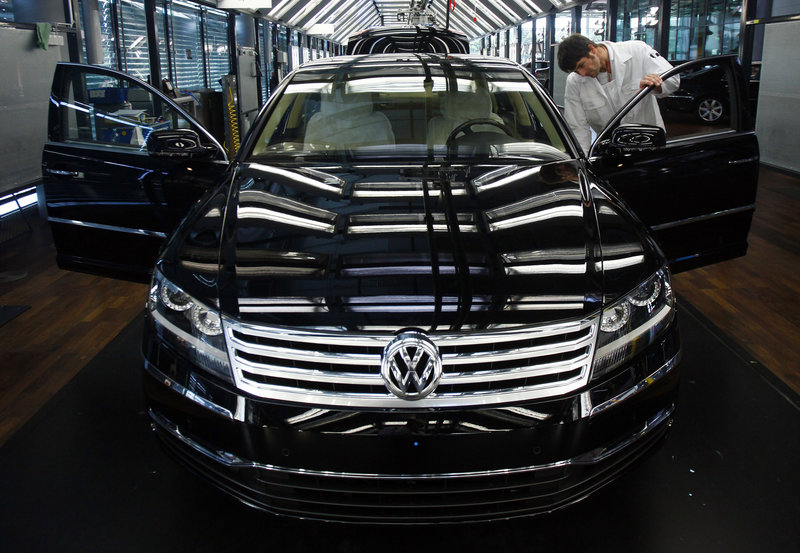– ANDREAS CREMER
Bloomberg News
BERLIN – Volkswagen plans to bring back the $85,000 Phaeton to the United States as part of the German carmaker’s aim of tripling its share of the world’s second-largest market by 2018. The luxury sedan previously flopped in America and was withdrawn in 2006,
“We have our eyes firmly set on the U.S. market,” said Juergen Borrmann, director of Volkswagen’s plant in Dresden, Germany, where the Phaeton is built. The model will be completely redesigned and retooled before VW begins selling it in the U.S. again, he said.
Former CEO Bernd Pischetsrieder pulled the Phaeton from the U.S. four years ago after the car failed to meet sales goals and called a 20,000 global target a “pipe dream.” His successor, Martin Winterkorn, later threw his full support behind the model and announced plans to keep the Phaeton. Sales last year fell 27 percent to 4,500 cars.
“The U.S. is a most lucrative market for high-end sedans and VW has to tackle that potential if it wants to credibly expand its U.S. presence,” said Willi Diez, head of the Nuertingen, Germany-based Institute for Automobile Industry, a state-funded think tank.
Volkswagen’s stock has advanced 21 percent this year, valuing the Wolfsburg, Germany-based carmaker at $44 billion.
Volkswagen this year is introducing an updated Phaeton, which has new front and rear sections, an interior upgrade and a wider selection of engines, as part of the model’s first overhaul since 2007. The face-lifted Phaeton entered European showrooms in June and goes on sale in China next month.
VW, Europe’s biggest carmaker, plans to reintroduce the Phaeton in the U.S. when the next generation of the model comes to market, Borrmann said in the Aug. 17 interview, declining to give a date.
Headed for its eighth straight annual loss in the U.S., VW aims to almost triple the carmaker’s share of the U.S. market to 6 percent by 2018 and boost deliveries to 1 million cars, including the Audi luxury unit. U.S. progress is a key component of Winterkorn’s goal of surpassing Toyota Motor Corp. in sales and profitability.
The Phaeton, named after the son of the Greek god Helios, went on sale in 2002, with development costs exceeding $1.3 billion. The model was part of an effort by Supervisory Board Chairman Ferdinand Piech, who was then CEO, to make the VW brand more upscale and compete against Bayerische Motoren Werke and Daimler’s Mercedes-Benz.
Axel Mees, Audi’s North American chief, was forced to leave the company in November 2004 after he criticized the Phaeton and Piech in an interview, saying he would not buy the car because it has a VW logo and was sold at Volkswagen dealerships alongside other volume brands.
Winterkorn, who took over as CEO on Jan. 1, 2007, has rejected criticism from analysts, including Ferdinand Dudenhoeffer of the Center for Automotive Research at the University of Duisburg-Essen, Germany, that the car has failed to compete with BMW and Mercedes while having high development and production costs.
“Without our flagship Phaeton, VW wouldn’t be where we are today in terms of technology and image,” Winterkorn said in April during a presentation of a face-lifted version of the current Phaeton in Beijing.
The Phaeton’s successor may be available in the United States by 2013 following the car’s latest revamp, Diez estimated.
For the first time since the Dresden plant, which does the Phaeton’s final assembly, began operations in 2001, production is running at full capacity and VW will add Saturday shifts to keep up with growing demand, Borrmann said.
“Business is developing very well; we’re headed for a record year,” Borrmann said in his office overlooking the all-glass factory’s assembly line. “We’re looking at a sustained upward trend, a really strong demand curve that’s also manifest in our orders.”
Year-to-date Phaeton sales have risen 15 percent, with China accounting for as much as 70 percent of deliveries, he said. Germany and South Korea, the second- and third-biggest markets for the car, are posting “slight” gains, he added.
The $238 million plant, one of Dresden’s top tourist sites alongside the city’s opera house and late baroque buildings, attracts about 90,000 visitors a year. Potential buyers regularly visit the Dresden plant to discuss features, collect vehicles or simply see the factory, Borrmann said.
Production areas have all-parquet floors with workers wearing white gowns, sometimes even white gloves as they assemble cars by hand. The factory’s most eye-catching building is a 131-foot glass tower where finished Phaetons are parked prior to delivery.
“We’re making the fascination of auto production visible to the outside world,” Borrmann said. “We’re completely laying open the complexity of how our top-end product is being assembled.”
Send questions/comments to the editors.



Success. Please wait for the page to reload. If the page does not reload within 5 seconds, please refresh the page.
Enter your email and password to access comments.
Hi, to comment on stories you must . This profile is in addition to your subscription and website login.
Already have a commenting profile? .
Invalid username/password.
Please check your email to confirm and complete your registration.
Only subscribers are eligible to post comments. Please subscribe or login first for digital access. Here’s why.
Use the form below to reset your password. When you've submitted your account email, we will send an email with a reset code.